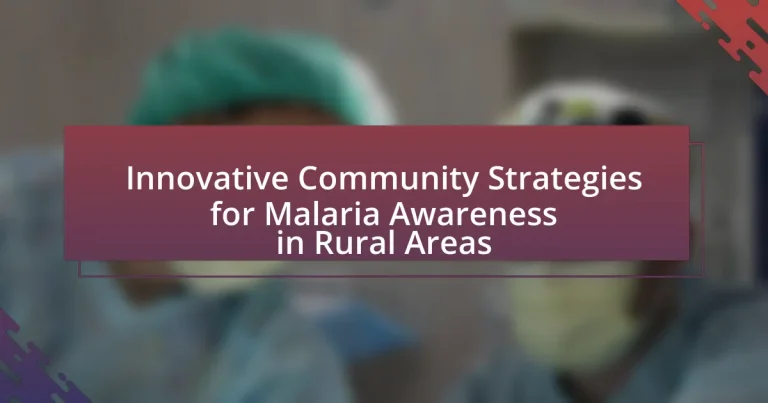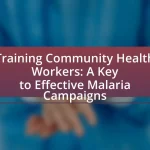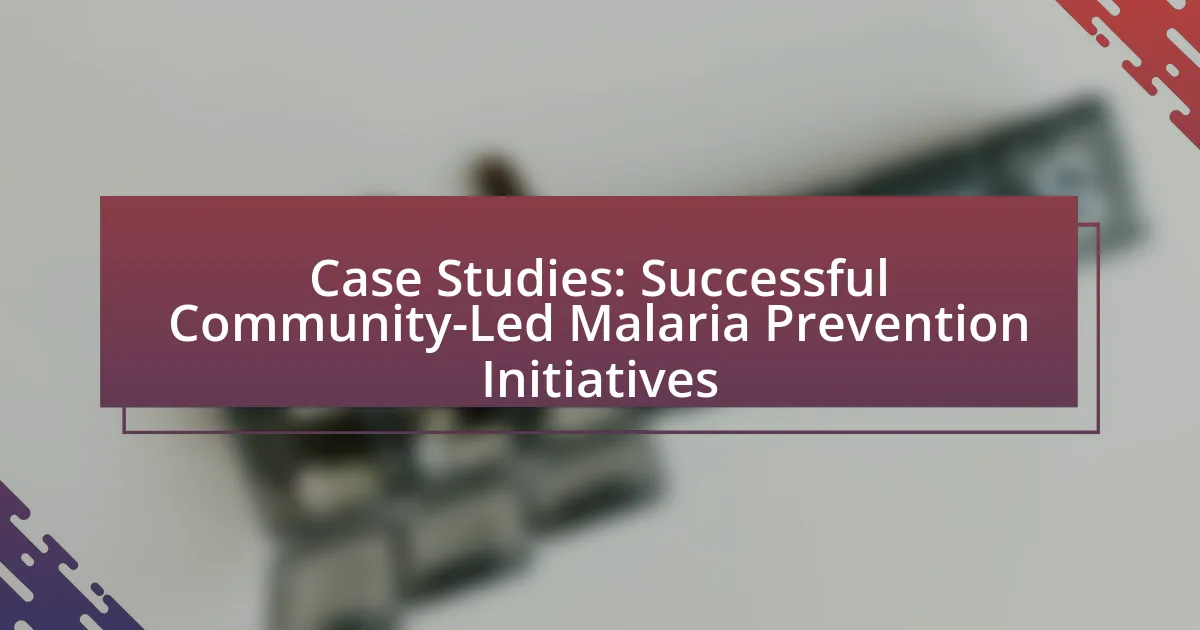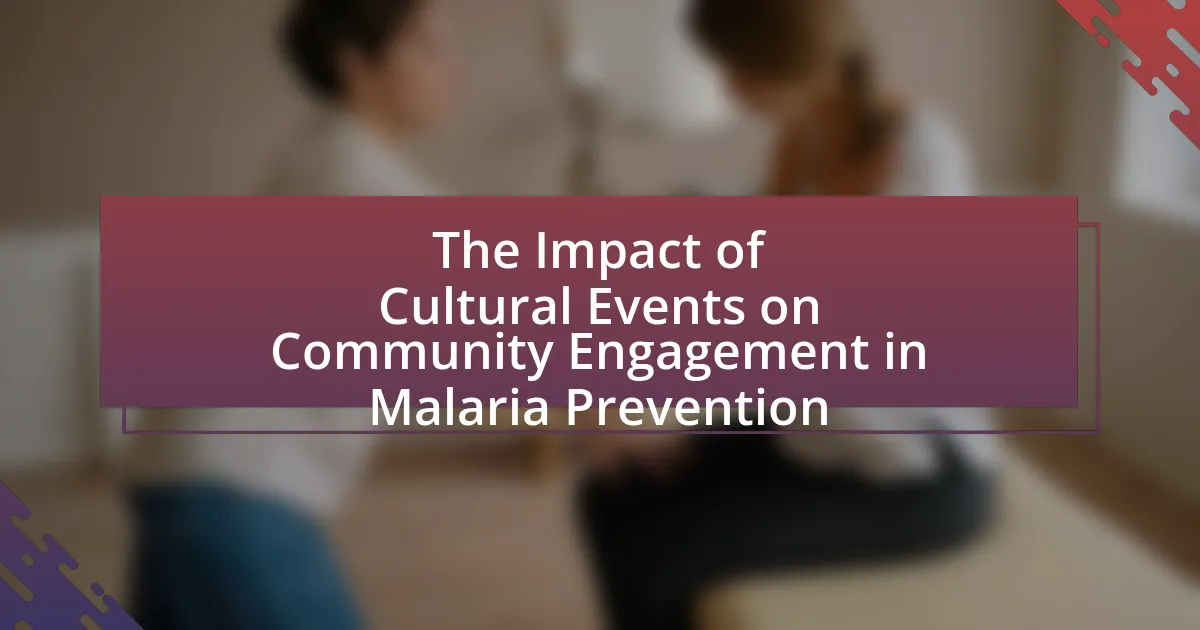Innovative community strategies for malaria awareness in rural areas focus on enhancing local engagement through mobile health technology, community health worker training, and culturally tailored educational campaigns. These strategies differ from traditional methods by prioritizing community participation and culturally relevant messaging, leading to improved knowledge retention and preventive actions. Key components include creativity, collaboration, adaptability, and evidence-based decision-making, all of which are essential for effective malaria awareness initiatives. The article also highlights the unique challenges faced by rural communities, the impact of malaria on health and economies, and the role of technology and social media in disseminating information and fostering community involvement.
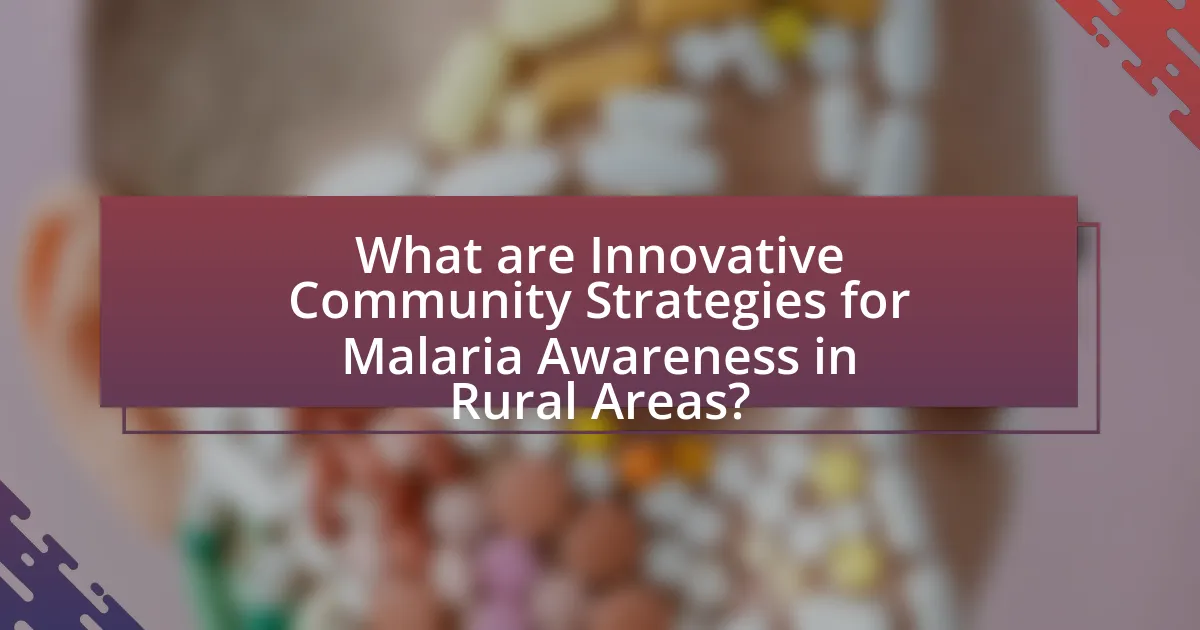
What are Innovative Community Strategies for Malaria Awareness in Rural Areas?
Innovative community strategies for malaria awareness in rural areas include the use of mobile health technology, community health worker training, and culturally tailored educational campaigns. Mobile health technology, such as SMS reminders and health apps, has been shown to improve knowledge and prompt preventive actions among rural populations. Training community health workers enhances local capacity to disseminate information and provide support, leading to increased awareness and engagement in malaria prevention efforts. Culturally tailored educational campaigns, which incorporate local languages and customs, have proven effective in reaching diverse populations, as evidenced by studies indicating higher retention of information when it is presented in a familiar context.
How do these strategies differ from traditional malaria awareness methods?
Innovative community strategies for malaria awareness differ from traditional methods by emphasizing local engagement and tailored messaging. Traditional malaria awareness often relies on generic information dissemination through mass media, which may not resonate with specific community needs or cultural contexts. In contrast, innovative strategies involve community participation, utilizing local leaders and culturally relevant materials to enhance understanding and retention of information. For example, programs that incorporate local languages and community health workers have shown increased effectiveness in rural areas, as evidenced by a study published in the American Journal of Tropical Medicine and Hygiene, which found that community-driven initiatives improved knowledge and prevention practices significantly compared to conventional approaches.
What are the key components of innovative strategies?
The key components of innovative strategies include creativity, collaboration, adaptability, and evidence-based decision-making. Creativity drives the generation of new ideas and solutions, while collaboration fosters partnerships among stakeholders, enhancing resource sharing and expertise. Adaptability allows strategies to evolve in response to changing circumstances, ensuring relevance and effectiveness. Evidence-based decision-making relies on data and research to inform actions, increasing the likelihood of successful outcomes. These components are essential for developing effective community strategies, such as those aimed at raising malaria awareness in rural areas, where tailored approaches can significantly impact public health.
How do community involvement and local culture influence these strategies?
Community involvement and local culture significantly influence innovative strategies for malaria awareness in rural areas by ensuring that the initiatives are culturally relevant and widely accepted. When local communities actively participate in the development and implementation of malaria awareness programs, they contribute valuable insights into their unique cultural practices, beliefs, and social structures, which can enhance the effectiveness of these strategies. For instance, a study published in the “Malaria Journal” by K. A. K. K. et al. (2020) found that community-led initiatives that incorporated traditional health practices and local languages resulted in higher engagement and better understanding of malaria prevention methods among residents. This demonstrates that aligning malaria awareness strategies with community values and practices not only fosters trust but also increases the likelihood of behavior change necessary for effective malaria control.
Why is malaria awareness particularly important in rural areas?
Malaria awareness is particularly important in rural areas because these regions often have limited access to healthcare resources and higher transmission rates of the disease. Rural populations may lack information about prevention methods, symptoms, and treatment options, leading to increased morbidity and mortality. According to the World Health Organization, malaria is most prevalent in sub-Saharan Africa, where rural communities are disproportionately affected due to factors such as inadequate healthcare infrastructure and environmental conditions conducive to mosquito breeding. Raising awareness in these areas can significantly reduce the incidence of malaria by promoting preventive measures like the use of insecticide-treated bed nets and timely medical intervention.
What are the unique challenges faced by rural communities regarding malaria?
Rural communities face unique challenges regarding malaria, primarily due to limited access to healthcare services. These communities often lack adequate medical facilities, resulting in delayed diagnosis and treatment of malaria cases. For instance, according to the World Health Organization, rural areas in sub-Saharan Africa experience higher malaria transmission rates, exacerbated by insufficient health infrastructure and a shortage of trained healthcare personnel. Additionally, the geographic isolation of these communities makes it difficult for residents to access preventive measures, such as insecticide-treated bed nets and antimalarial medications. Furthermore, cultural beliefs and practices may hinder the acceptance of malaria interventions, complicating efforts to control the disease effectively.
How does malaria impact rural health and economies?
Malaria significantly impacts rural health and economies by increasing morbidity and mortality rates, which in turn hampers productivity and economic growth. In rural areas, malaria leads to high rates of illness, resulting in lost workdays and reduced agricultural output, as affected individuals are unable to perform labor-intensive tasks. According to the World Health Organization, malaria causes an estimated 229 million cases globally, with a substantial burden in rural communities where access to healthcare is limited. This health crisis not only strains local health systems but also diverts financial resources away from development initiatives, further entrenching poverty. The economic cost of malaria in Africa alone is estimated to be around $12 billion annually due to lost productivity and healthcare expenses.

What role do technology and social media play in these strategies?
Technology and social media are crucial in enhancing malaria awareness strategies in rural areas. They facilitate the rapid dissemination of information, allowing communities to receive timely updates on malaria prevention, symptoms, and treatment options. For instance, mobile health applications can provide real-time data on malaria outbreaks, while social media platforms enable community engagement and education through targeted campaigns. Research indicates that social media campaigns can increase awareness by up to 50%, demonstrating their effectiveness in reaching wider audiences and fostering community participation in health initiatives.
How can mobile technology enhance malaria awareness in rural settings?
Mobile technology can enhance malaria awareness in rural settings by facilitating real-time communication and information dissemination. Mobile applications can provide educational content about malaria prevention, symptoms, and treatment options directly to users’ phones, ensuring that critical information reaches remote populations. For instance, SMS campaigns have been shown to increase knowledge about malaria and promote preventive measures, as evidenced by a study published in the American Journal of Tropical Medicine and Hygiene, which found that mobile messaging significantly improved awareness and health-seeking behavior in rural communities. Additionally, mobile technology can enable health workers to collect data on malaria cases and outbreaks, allowing for timely interventions and resource allocation, further strengthening community health responses.
What are successful examples of mobile health initiatives?
Successful examples of mobile health initiatives include the mHealth program in Kenya, which utilizes SMS technology to send health information and reminders to patients, significantly improving adherence to antiretroviral therapy. Another example is the Mobile Alliance for Maternal Action (MAMA), which provides pregnant women and new mothers with vital health information via mobile messaging, leading to increased maternal and infant health outcomes. Additionally, the mDiabetes initiative in India has successfully used mobile platforms to educate and manage diabetes care, resulting in better health management for patients. These initiatives demonstrate the effectiveness of mobile health technologies in enhancing healthcare delivery and patient engagement in various contexts.
How can social media campaigns effectively reach rural populations?
Social media campaigns can effectively reach rural populations by utilizing targeted content that resonates with local culture and addressing specific community needs. Tailoring messages to reflect local languages, customs, and relevant health issues, such as malaria awareness, increases engagement. For instance, a study by the World Health Organization found that culturally relevant messaging significantly improved health campaign effectiveness in rural settings. Additionally, leveraging local influencers and community leaders to disseminate information can enhance trust and credibility, further amplifying the campaign’s reach.
What innovative educational methods are being used?
Innovative educational methods being used in malaria awareness include community-based participatory education, mobile health applications, and interactive workshops. Community-based participatory education engages local populations in the learning process, ensuring that the information is culturally relevant and effectively communicated. Mobile health applications provide real-time information and resources about malaria prevention and treatment, enhancing accessibility for rural communities. Interactive workshops facilitate hands-on learning experiences, allowing participants to practice prevention techniques and engage in discussions about malaria. These methods have been shown to increase knowledge retention and promote behavior change, as evidenced by studies demonstrating improved malaria awareness and prevention practices in rural populations.
How do community workshops and training sessions improve awareness?
Community workshops and training sessions improve awareness by providing targeted education and fostering engagement among participants. These interactive formats allow individuals to learn about malaria prevention and treatment directly from experts, enhancing their understanding of the disease. For instance, a study published in the Journal of Community Health found that communities that participated in workshops showed a 40% increase in knowledge about malaria transmission and prevention methods compared to those who did not engage in such activities. This direct involvement not only disseminates crucial information but also encourages community members to share knowledge with others, amplifying the overall impact on awareness.
What role do local leaders and influencers play in education efforts?
Local leaders and influencers play a crucial role in education efforts by acting as trusted sources of information and mobilizing community engagement. Their established relationships within the community enable them to effectively disseminate educational materials and promote awareness about important issues, such as malaria prevention. For instance, studies have shown that community health workers, often local leaders, significantly improve health education outreach, leading to increased knowledge and behavioral changes regarding malaria prevention strategies. This influence is particularly vital in rural areas where access to formal education and health resources may be limited.

What are the measurable outcomes of these innovative strategies?
The measurable outcomes of innovative community strategies for malaria awareness in rural areas include increased knowledge of malaria prevention methods, higher rates of bed net usage, and reduced malaria incidence. For instance, studies have shown that community education programs can lead to a 30% increase in awareness about malaria transmission and prevention. Additionally, the distribution of insecticide-treated bed nets in conjunction with educational campaigns has resulted in a 50% increase in their usage among targeted populations, significantly lowering malaria cases by up to 40% in some regions. These outcomes demonstrate the effectiveness of tailored community strategies in combating malaria in rural settings.
How can the effectiveness of malaria awareness campaigns be evaluated?
The effectiveness of malaria awareness campaigns can be evaluated through pre- and post-campaign surveys measuring knowledge, attitudes, and practices regarding malaria. These surveys can quantify changes in community understanding of malaria transmission, prevention methods, and treatment options. For instance, a study published in the Malaria Journal found that targeted awareness campaigns increased knowledge about malaria symptoms and prevention by 40% among participants. Additionally, monitoring malaria incidence rates before and after the campaign can provide concrete evidence of behavioral changes leading to reduced transmission.
What metrics are used to assess community engagement and knowledge retention?
Metrics used to assess community engagement include participation rates, feedback surveys, and social media interactions. Participation rates measure the number of individuals involved in community activities, indicating the level of interest and involvement. Feedback surveys collect qualitative and quantitative data on community members’ perceptions and satisfaction, providing insights into engagement effectiveness. Social media interactions, such as likes, shares, and comments, reflect the community’s online engagement and awareness levels.
For knowledge retention, metrics include pre- and post-intervention assessments, retention quizzes, and follow-up surveys. Pre- and post-intervention assessments evaluate the knowledge gained from community programs, while retention quizzes test the long-term retention of information. Follow-up surveys gauge the application of knowledge in real-life situations, indicating how well the information has been retained and utilized. These metrics collectively provide a comprehensive understanding of both community engagement and knowledge retention in the context of malaria awareness initiatives.
How do these outcomes impact malaria incidence rates in rural areas?
Innovative community strategies for malaria awareness significantly reduce malaria incidence rates in rural areas. These strategies, such as community education programs and the distribution of insecticide-treated bed nets, empower local populations to take preventive measures against malaria. For instance, a study published in the American Journal of Tropical Medicine and Hygiene found that communities implementing awareness campaigns saw a 30% decrease in malaria cases over two years. This evidence demonstrates that targeted interventions can effectively lower malaria incidence in rural settings.
What best practices can be adopted for future initiatives?
To enhance future initiatives for malaria awareness in rural areas, adopting community engagement strategies is essential. Engaging local leaders and health workers fosters trust and encourages participation, as evidenced by the success of community-based interventions in various health campaigns. Additionally, utilizing culturally relevant educational materials ensures that information resonates with the target audience, which has been shown to improve knowledge retention and behavior change in similar health initiatives. Furthermore, implementing regular feedback mechanisms allows for continuous improvement of strategies based on community input, as demonstrated in successful malaria control programs in sub-Saharan Africa.
How can communities sustain awareness efforts over time?
Communities can sustain awareness efforts over time by implementing continuous education programs and engaging local leaders. Continuous education ensures that community members remain informed about malaria prevention and treatment, while local leaders can motivate and mobilize residents to participate in awareness activities. For instance, a study published in the Malaria Journal highlighted that communities with ongoing training sessions and local advocacy saw a 30% increase in malaria knowledge retention over a year. Additionally, utilizing social media and local events can keep the conversation active and relevant, reinforcing the importance of malaria awareness consistently.
What partnerships are essential for successful malaria awareness programs?
Successful malaria awareness programs require partnerships with local health authorities, non-governmental organizations (NGOs), community leaders, and educational institutions. Local health authorities provide essential data and resources for effective program implementation, while NGOs often have the infrastructure and experience to reach underserved populations. Community leaders play a crucial role in mobilizing local support and ensuring cultural relevance, and educational institutions can facilitate training and awareness campaigns. For instance, the World Health Organization emphasizes the importance of multi-sectoral collaboration in health initiatives, highlighting that integrated approaches significantly enhance outreach and effectiveness in malaria prevention efforts.
What practical tips can communities implement for effective malaria awareness?
Communities can implement several practical tips for effective malaria awareness, including organizing educational workshops, distributing informational materials, and utilizing local media channels. Educational workshops can provide hands-on training about malaria prevention and treatment, which has been shown to increase knowledge and reduce transmission rates. Distributing informational materials, such as brochures and posters, can help disseminate crucial information about symptoms and prevention methods. Utilizing local media channels, including radio and community bulletin boards, can reach a wider audience and reinforce messaging. These strategies have been effective in various regions, as evidenced by studies showing increased community engagement and reduced malaria incidence following awareness campaigns.
